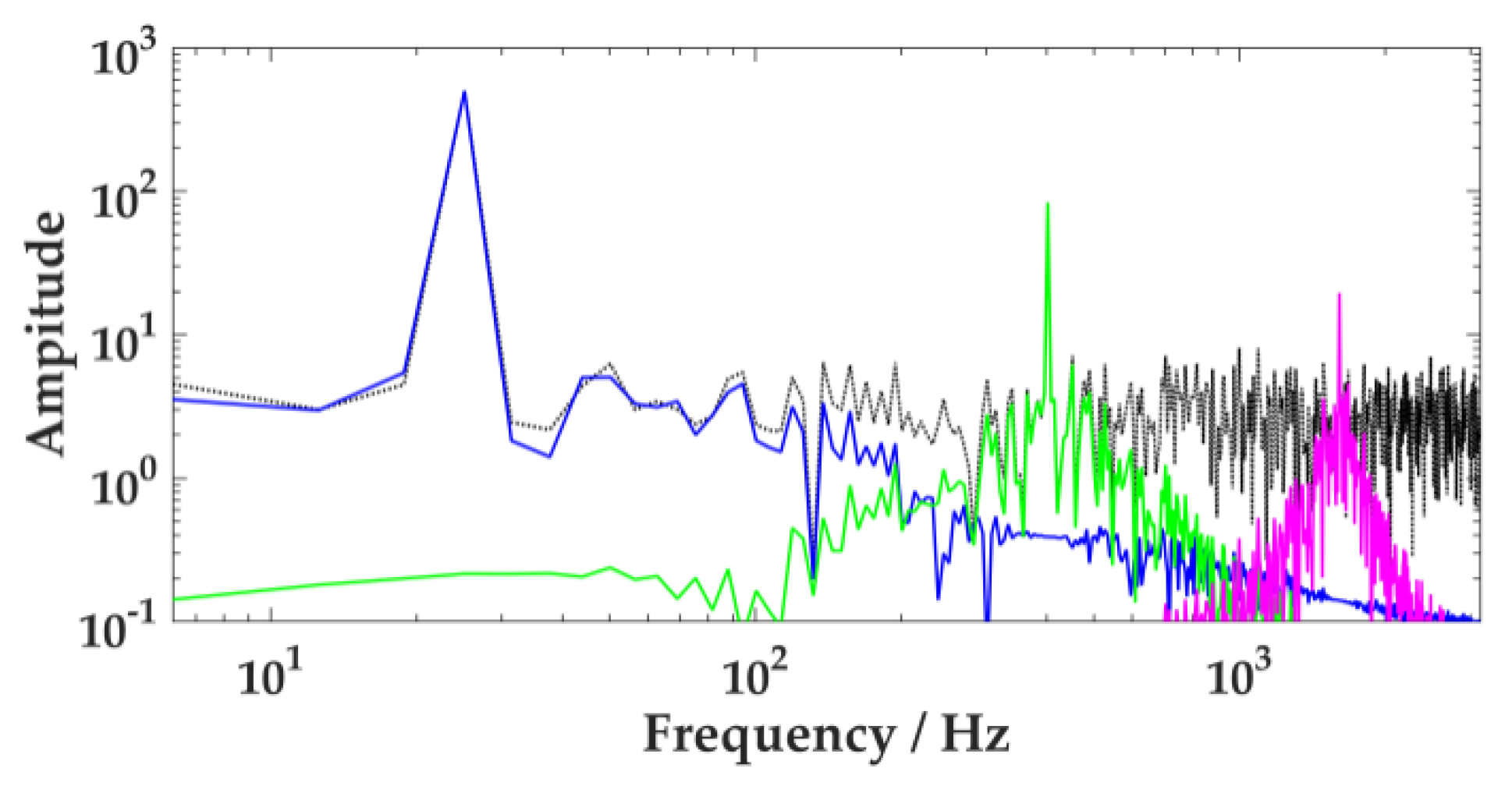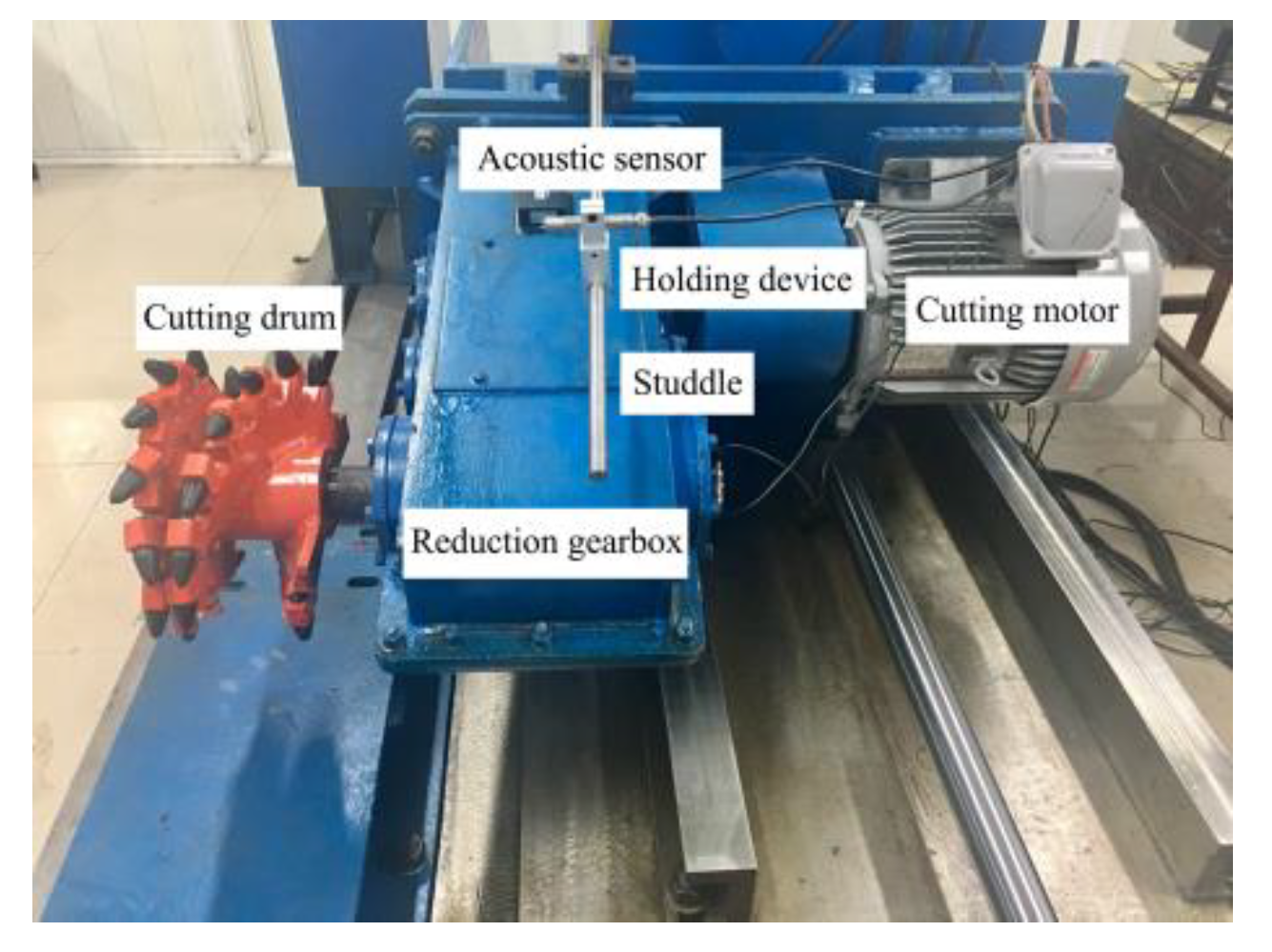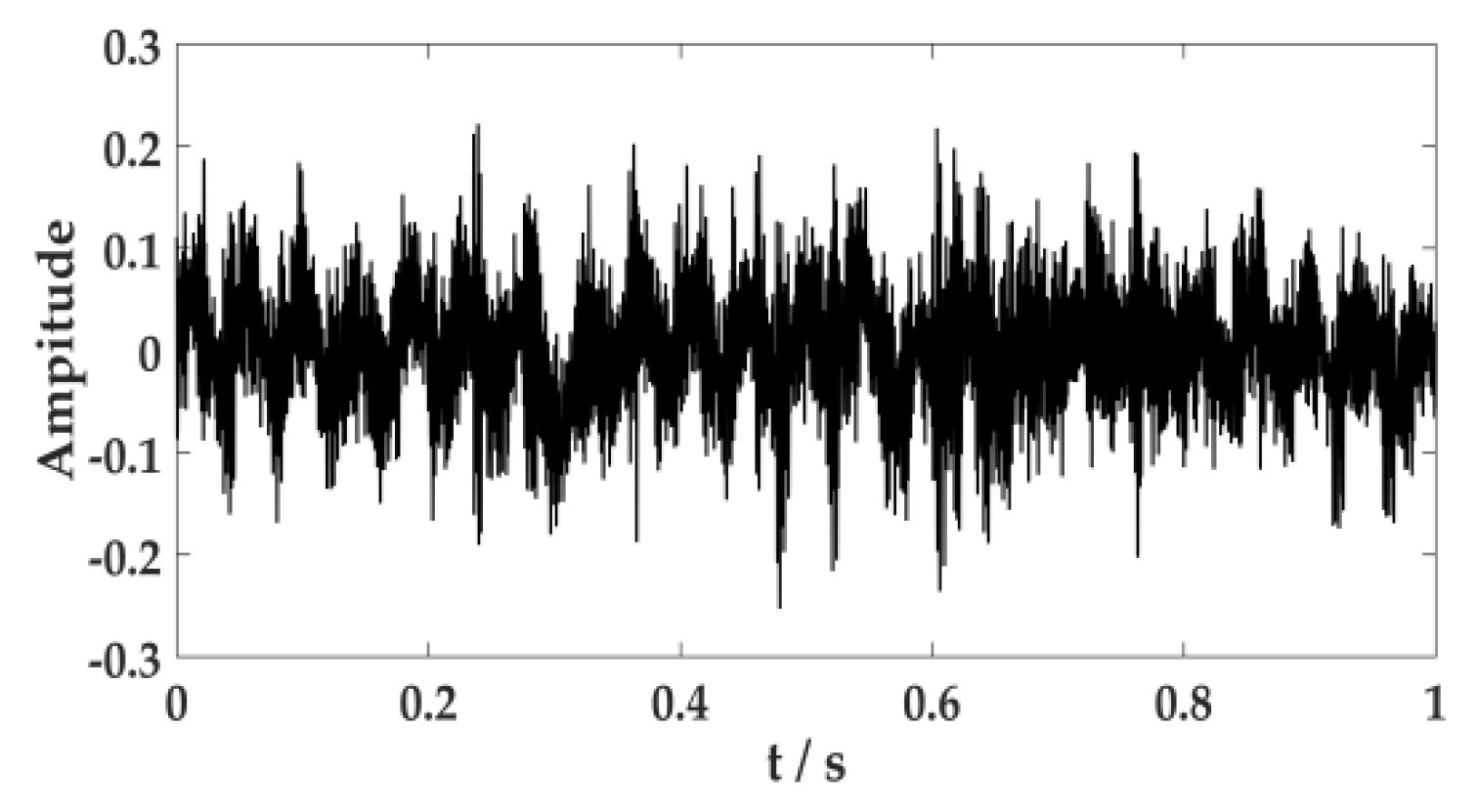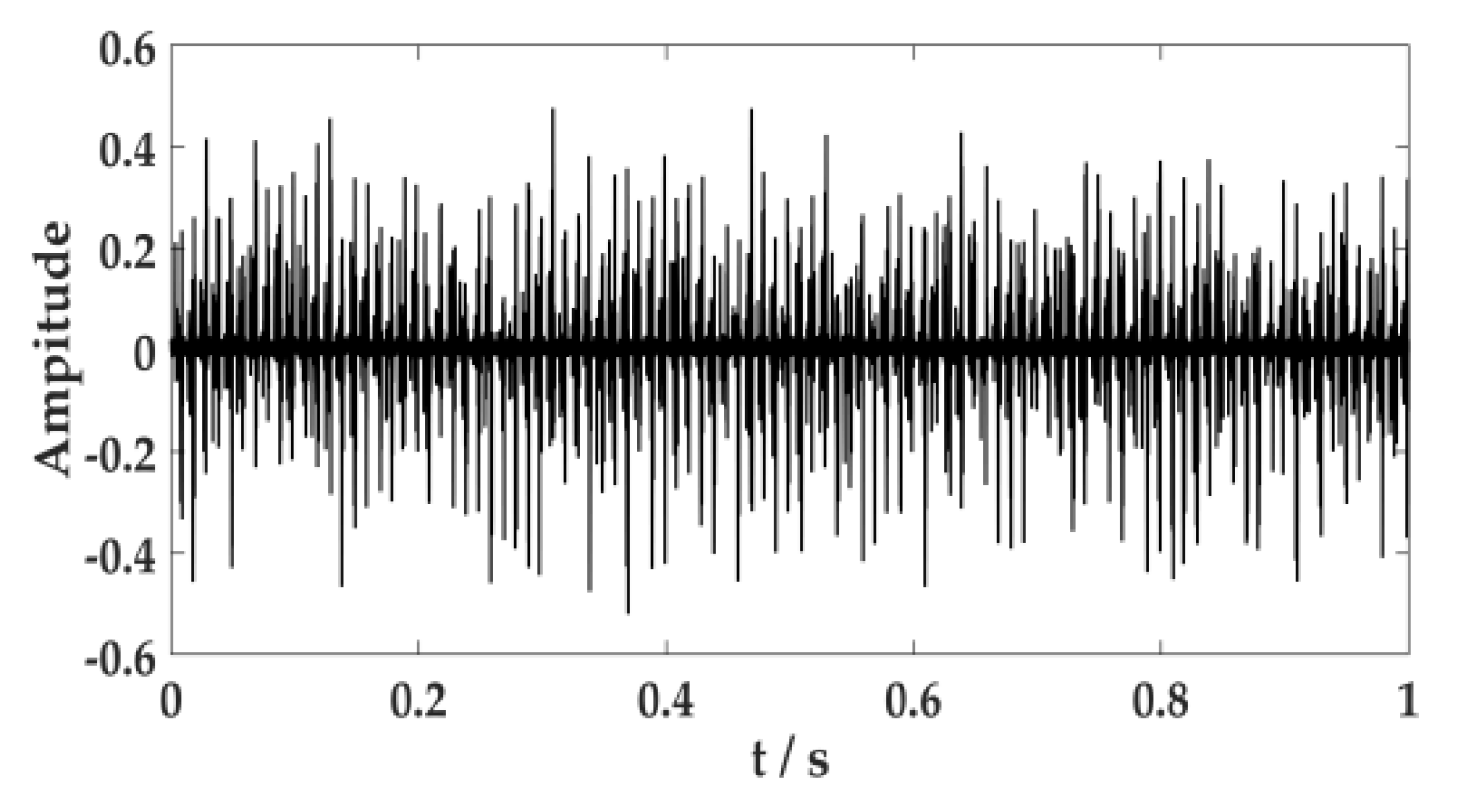A Novel Approach for Acoustic Signal Processing of a Drum Shearer Based on Improved Variational Mode Decomposition and Cluster Analysis
Abstract
1. Introduction
2. Basic Theory
2.1. Variational Mode Decomposition
2.1.1. Basic Principles of VMD
2.1.2. VMD Iterative Operation
- 1
- Initialize , ,, n.
- 2
- Update and according to Formulas (8) and (9).
- 3
- Preset the fidelity coefficient τ. Update λ according to Formula (10):
- 4
- Set the precision . Settle the criteria as Formula (11). If the condition is met, the iteration is terminated. Otherwise, return to step (2) and continue the loop.
2.2. Particle Swarm Optimization
- 1
- Particle swarm initialization: set the initial velocity and initial position of each particle randomly.
- 2
- The new position of each particle will be generated by the initial velocity and position.
- 3
- Calculate the fitness of particles.
- 4
- Compare the fitness value of arbitrary particles with the fitness value of the optimal position it experienced. If there exists a better fitness value, it will update.
- 5
- Compare the fitness value of any particle with the fitness value of the optimal position passed by the population. If there is a better fitness value, then will be replaced.
- 6
- Adjust the position and speed of particles according to Formulas (12) and (13).
- 7
- If the ideal position is searched or the maximum number of iterations is reached, the optimization ends. Otherwise, repeat steps 3 to 6.
2.3. Clustering Analysis of PSO
- 1
- The clustering division of particle i can be determined by the nearest neighbor method of Formula (15).
- 2
- On the basis of the partitioned clusters, the cluster center recalculates. Then, count the total within-class scatter J according to Formula (14).
- 3
- The fitness computing Formula (16) of particle i is as follows:where k is a constant that depends on the specific situation. The fitness value of particle i negatively correlates with the J value of the clustering partition.
3. Parameter Optimization of VMD
- 1
- Initialize the parameters of PSO.
- 2
- Determine the fitness function in optimization.
- 3
- Initialize the particle population. A certain number of parameter combinations [K, α] are randomly generated as the initial positions of particles. Stochastically initialize the movement speed of each particle.
- 4
- When the particles are in different positions, VMD processes the signals. Count the fitness value of the corresponding position of any [K, α].
- 5
- Compare the size of fitness values and update and .
- 6
- Update the velocity and position of particles according to Formulas (11) and (12).
- 7
- If gaining the optimal position or reaching the maximum number of iterations, the optimization ends. Otherwise, repeat steps 4 to 6.
4. Simulation Signal Analysis
5. Acoustic Signal Analysis and Classification of the Drum Shearer
5.1. Signal Acquisition
5.2. Signal Analysis
5.3. Acoustic Signal Classification of PSO Optimized Clustering Algorithm
6. Conclusions and Prospects
Author Contributions
Funding
Acknowledgments
Conflicts of Interest
References
- Yang, H.; Li, W.; Luo, C.; Zhang, J.; Si, Z. Research on Error Compensation Property of Strapdown Inertial Navigation System Using Dynamic Model of Shearer. IEEE Access 2016, 4, 2045–2055. [Google Scholar] [CrossRef]
- Bessinger, S.L.; Neison, M.G. Remnant roof coal thickness measurement with passive gamma ray instruments in coal mine. IEEE Trans. Ind. Appl. 1993, 29, 562–565. [Google Scholar] [CrossRef]
- Fan, S.Z.; Geng, M.X.; Xu, J.P. The application of pattern recognition in the automatic vertical steering system of shearer’s drum. Intel. J. Coal. Sci. Technol. 1996, 2, 105–110. [Google Scholar]
- Sun, J.; Su, B. Coal–rock interface detection on the basis of image texture features. Int. J. Mining Sci. Technol. 2013, 23, 681–687. [Google Scholar] [CrossRef]
- Zhang, Q.; Wang, H.J.; Wang, Z.; Wen, X.Z. Analysis of Coal—Rock’s Cutting Characteristics and Flash Temperature for Peak Based on Infrared Thermal Image Testing. Chin. J. Sens. Actuators 2016, 29, 686–692. [Google Scholar]
- Xu, J.; Wang, Z.; Tan, C.; Si, L.; Liu, X. A cutting pattern recognition method for shearers based on improved ensemble empirical mode decomposition and a probabilistic neural network. Sensors 2015, 15, 27721–27737. [Google Scholar] [CrossRef]
- Xu, J.; Wang, Z.; Tan, C.; Si, L.; Liu, X. Cutting pattern identification for coal mining shearer through a swarm intelligence–based variable translation wavelet neural network. Sensors 2018, 18, 382. [Google Scholar] [CrossRef]
- Si, L.; Wang, Z.; Liu, X.; Tan, C. A sensing identification method for shearer cutting state based on modified multi-scale fuzzy entropy and support vector machine. Eng. Appl. Artif. Intell. 2019, 78, 86–101. [Google Scholar] [CrossRef]
- Song, Q.J.; Jiang, H.; Song, Q.H.; Zhao, X.G.; Wu, X.X. Combination of minimum enclosing balls classifier with SVM in coal-rock recognition. PLoS ONE 2017, 12, e0184834. [Google Scholar] [CrossRef]
- Song, Q.; Jiang, H.; Zhao, X.; Li, D. An automatic decision approach to coal–rock recognition in top coal caving based on MF-Score. Pattern Anal. Appl. 2017, 20, 1307–1315. [Google Scholar] [CrossRef]
- Li, J.; Yue, J.; Yang, Y.; Zhan, X.; Zhao, L. Multi-Resolution Feature Fusion model for coal rock burst hazard recognition based on Acoustic Emission data. Measurement 2017, 100, 329–336. [Google Scholar] [CrossRef]
- Wang, H.; Zhang, Q. Dynamic identification of coal-rock interface based on adaptive weight optimization and multi-sensor information fusion. Inform. Fusion 2019, 51, 114–128. [Google Scholar] [CrossRef]
- Lazarev, I.E.; Sayfulina, K.E.; Chernysheva, E.G.; Bryzgalov, D.V.; Chernyshev, B.V. Feature binding in auditory modality requires attention as indexed by mismatch negativity and N2b in an active discrimination task. NeuroReport 2018, 29, 308–313. [Google Scholar] [CrossRef] [PubMed]
- Jiménez-Fernández, A.; Cerezuela-Escudero, E.; Miró-Amarante, L.; Domínguez-Morales, M.J.; de Asís Gómez-Rodríguez, F.; Linares-Barranco, A.; Jiménez-Moreno, G. A binaural neuromorphic auditory sensor for FPGA: A spike signal processing approach. IEEE. Trans. Neur. Net. Lear. Syst. 2016, 28, 804–818. [Google Scholar] [CrossRef] [PubMed]
- Ingerman, E.A.; London, R.A.; Heintzmann, R.; Gustafsson, M.G.L. Signal, noise and resolution in linear and nonlinear structured-illumination microscopy. J. Microsc. 2019, 273, 3–25. [Google Scholar] [CrossRef]
- Goyal, B.; Dogra, A.; Agrawal, S.; Sohi, B.S.; Sharma, A. Image denoising review: From classical to state-of-the-art approaches. Inform. Fus. 2020, 55, 220–244. [Google Scholar] [CrossRef]
- Wang, P.; Fu, H.; Zhang, K. A pixel-level entropy-weighted image fusion algorithm based on bidimensional ensemble empirical mode decomposition. Int. J. Distrib. Sens. Netw. 2018, 14. [Google Scholar] [CrossRef]
- Zhang, N.; Lin, A.; Shang, P. Multidimensional k-nearest neighbor model based on EEMD for financial time series forecasting. Phys. A Stat. Mech. Appl. 2017, 477, 161–173. [Google Scholar] [CrossRef]
- Wang, Z.; Wang, J.; Cai, W.; Zhou, J.; Du, W.; Wang, J.; He, G.; He, H. Application of an improved ensemble local mean decomposition method for gearbox composite fault diagnosis. Complexity 2019, 2019, 1564243. [Google Scholar] [CrossRef]
- Yan, R.; Gao, R.X.; Chen, X. Wavelets for fault diagnosis of rotary machines: A review with applications. Signal Process. 2014, 96, 1–15. [Google Scholar] [CrossRef]
- Huang, N.E.; Wu, Z. A review on Hilbert-Huang transform: Method and its applications to geophysical studies. Rev. Geophys. 2008, 46, RG2006. [Google Scholar] [CrossRef]
- Klionskiy, D.; Kupriyanov, M.; Kaplun, D. Signal denoising based on empirical mode decomposition. J. Vibroeng. 2017, 19, 5560–5570. [Google Scholar] [CrossRef]
- Wang, S.; Zhang, N.; Wu, L.; Wang, Y. Wind speed forecasting based on the hybrid ensemble empirical mode decomposition and GA-BP neural network method. Renew. Energ. 2016, 94, 629–636. [Google Scholar] [CrossRef]
- Zhang, X.; Liang, Y.; Zhou, J. A novel bearing fault diagnosis model integrated permutation entropy, ensemble empirical mode decomposition and optimized SVM. Measurement 2015, 69, 164–179. [Google Scholar] [CrossRef]
- Yang, Y.; Cheng, J.; Zhang, K. An ensemble local means decomposition method and its application to local rub-impact fault diagnosis of the rotor systems. Measurement 2012, 45, 561–570. [Google Scholar] [CrossRef]
- Dragomiretskiy, K.; Zosso, D. Variational mode decomposition. IEEE. Trans. Signal. Process. 2013, 62, 531–544. [Google Scholar] [CrossRef]
- Wang, Y.; Markert, R.; Xiang, J.; Zheng, W. Research on variational mode decomposition and its application in detecting rub-impact fault of the rotor system. Mech. Syst. Signal. Process. 2015, 60, 243–251. [Google Scholar] [CrossRef]
- Li, Z.; Chen, J.; Zi, Y.; Pan, J. Independence-oriented VMD to identify fault feature for wheel set bearing fault diagnosis of high speed locomotive. Mech. Syst. Signal. Process. 2017, 85, 512–529. [Google Scholar] [CrossRef]
- Yan, X.; Jia, M.; Xiang, L. Compound fault diagnosis of rotating machinery based on OVMD and a 1.5-dimension envelope spectrum. Meas. Sci. Technol. 2016, 27. [Google Scholar] [CrossRef]
- Yi, C.; Lv, Y.; Dang, Z. A Fault Diagnosis Scheme for Rolling Bearing Based on Particle Swarm Optimization in Variational Mode Decomposition. Shock Vib. 2016, 1–10. [Google Scholar] [CrossRef]
- Zhang, X.; Miao, Q.; Zhang, H.; Wang, L. A parameter-adaptive VMD method based on grasshopper optimization algorithm to analyze vibration signals from rotating machinery. Mech. Syst. Signal Process. 2018, 108, 58–72. [Google Scholar] [CrossRef]
- Yan, X.; Jia, M. Application of CSA-VMD and optimal scale morphological slice bispectrum in enhancing outer race fault detection of rolling element bearings. Mech. Syst. Signal Process. 2019, 122, 56–86. [Google Scholar] [CrossRef]
- Zheng, X.; Wang, S.; Qian, Y. Fault feature extraction of wind turbine gearbox under variable speed based on improved adaptive variational mode decomposition. Proc. Inst. Mech. Eng. Part J. Pow. Eng. 2019, 1–14. [Google Scholar] [CrossRef]
- Mok, P.Y.; Huang, H.Q.; Kwok, Y.L.; Au, J.S. A robust adaptive clustering analysis method for automatic identification of clusters. Pattern Recognit. 2012, 45, 3017–3033. [Google Scholar] [CrossRef]
- Ahmad, A.; Hashmi, S. K-Harmonic means type clustering algorithm for mixed datasets. Appl. Soft Comput. 2016, 48, 39–49. [Google Scholar] [CrossRef]
- Baraldi, P.; Di Maio, F.; Rigamonti, M.; Zio, E.; Seraoui, R. Clustering for unsupervised fault diagnosis in nuclear turbine shut-down transients. Mech. Syst. Signal Process. 2015, 58, 160–178. [Google Scholar] [CrossRef]
- Tang, J.; Zhang, G.; Wang, Y.; Wang, H.; Liu, F. A hybrid approach to integrate fuzzy C-means based imputation method with genetic algorithm for missing traffic volume data estimation. Transp. Res. Part Emerg. Technol. 2015, 51, 29–40. [Google Scholar] [CrossRef]
- Biniaz, A.; Abbasi, A. Unsupervised ACO: Applying FCM as a supervisor for ACO in medical image segmentation. J. Intell. Fuzzy Syst. 2014, 27, 407–417. [Google Scholar] [CrossRef]
- Guofeng, J.; Wei, Z.; Zhengwei, Y.; Zhiyong, H.; Yuanjia, S.; Dongdong, W.; Gan, T. Image segmentation of thermal waving inspection based on particle swarm optimization fuzzy clustering algorithm. Meas. Sci. Rev. 2012, 12, 296–301. [Google Scholar] [CrossRef]
- Duan, H.; Luo, Q. New progresses in swarm intelligence–based computation. Int. J. Bio Inspir. Comp. 2015, 7, 26–35. [Google Scholar] [CrossRef]
- Yahya, A.A.; Osman, A.; El-Bashir, M.S. Rocchio algorithm-based particle initialization mechanism for effective PSO classification of high dimensional data. Swarm Evol. Comput. 2017, 34, 18–32. [Google Scholar] [CrossRef]
- Malik, S.; Kim, D.H. Prediction-learning algorithm for efficient energy consumption in smart buildings based on particle regeneration and velocity boost in particle swarm optimization neural networks. Energies 2018, 11, 1289. [Google Scholar] [CrossRef]
- Maleki, A.; Ameri, M.; Keynia, F. Scrutiny of multifarious particle swarm optimization for finding the optimal size of a PV/wind/battery hybrid system. Renew. Energ. 2015, 80, 552–563. [Google Scholar] [CrossRef]
- Tang, G.J.; Wang, X.L. Parameter Optimized Variational Mode Decomposition Method with App-lication to Incipient Fault Diagnosis of Rolling Bearing. Chin. J. Xi’An Jiaotong Univ. 2015, 49, 73–81. [Google Scholar]

















| M | |||||
|---|---|---|---|---|---|
| 1.5 | 1.5 | 0.4 | 0.9 | 20 | 20 |
| Performance Parameter | Index Value |
|---|---|
| Number of analog input channels | 16 differential or 32 single ended |
| Analog–digital converter resolution | 16 bits |
| Single channel maximum sampling rate | 250 kS/s |
| Number of analog output channels | 4 channels |
| Digital–analog converter resolution | 16 bits |
| Signal channel maximum updated rate | 900 kS/s |
| Transmission Parameters | High-Speed Gear Set | Low-Speed Gear Set |
|---|---|---|
| Gear modulus | 3 | 3 |
| Number of pinion teeth | 24 | 30 |
| Number of large gear teeth | 76 | 73 |
| Transmission ratio | 3.166 | 2.433 |
| Pressure angle (°) | 20 | 20 |
| Experience Group | Optimal Envelope Entropy |
|---|---|
| 1 | [7.4883, 7.4443, 7.3487, 7.4516, 7.5074, 7.7370, 7.9055, 7.5466, 7.3212, 7.3465, 7.3406, 7.2994, 7.4831, 7.4870, 7.2313, 7.4551, 7.6440, 7.3354, 7.4853, 7.4946, 7.5568, 7.4802, 7.4539, 7.4824, 7.3477, 7.4989, 7.3541, 7.5143, 7.4427, 7.5808, 7.8402, 7.5027, 7.2932, 7.3216, 7.6472, 7.4759, 7.4542, 7.4661, 7.4849, 7.2856] |
| 2 | [8.0925, 7.9822, 8.0960, 8.1214, 8.0436, 7.9766, 8.0436, 7.9983, 7.9526, 7.9896, 8.0836, 8.1699, 7.9583, 7.9885, 8.0601, 8.1000, 7.9492, 7.9937, 8.1170, 8.0792, 7.9660, 8.1463, 8.1404, 7.9877, 8.0229, 8.0735, 8.0397, 8.0138, 7.9815, 7.9750, 8.0153, 8.0927, 8.0774, 8.0119, 7.9693, 8.0375, 8.0345, 7.9721, 7.9597, 8.0176] |
| Compared Methods | Recognition Accuracy |
|---|---|
| WPT-PNN | 78.33% |
| EEMD-VTWNN | 84.75% |
| IEEMD-PNN | 92.67% |
| MFS-MEB-SVM | 94.42% |
| EEMD-VTWNN-MBA | 95.25% |
| The proposed method | 96.25% |
© 2020 by the authors. Licensee MDPI, Basel, Switzerland. This article is an open access article distributed under the terms and conditions of the Creative Commons Attribution (CC BY) license (http://creativecommons.org/licenses/by/4.0/).
Share and Cite
Li, C.; Peng, T.; Zhu, Y. A Novel Approach for Acoustic Signal Processing of a Drum Shearer Based on Improved Variational Mode Decomposition and Cluster Analysis. Sensors 2020, 20, 2949. https://doi.org/10.3390/s20102949
Li C, Peng T, Zhu Y. A Novel Approach for Acoustic Signal Processing of a Drum Shearer Based on Improved Variational Mode Decomposition and Cluster Analysis. Sensors. 2020; 20(10):2949. https://doi.org/10.3390/s20102949
Chicago/Turabian StyleLi, Changpeng, Tianhao Peng, and Yanmin Zhu. 2020. "A Novel Approach for Acoustic Signal Processing of a Drum Shearer Based on Improved Variational Mode Decomposition and Cluster Analysis" Sensors 20, no. 10: 2949. https://doi.org/10.3390/s20102949
APA StyleLi, C., Peng, T., & Zhu, Y. (2020). A Novel Approach for Acoustic Signal Processing of a Drum Shearer Based on Improved Variational Mode Decomposition and Cluster Analysis. Sensors, 20(10), 2949. https://doi.org/10.3390/s20102949




